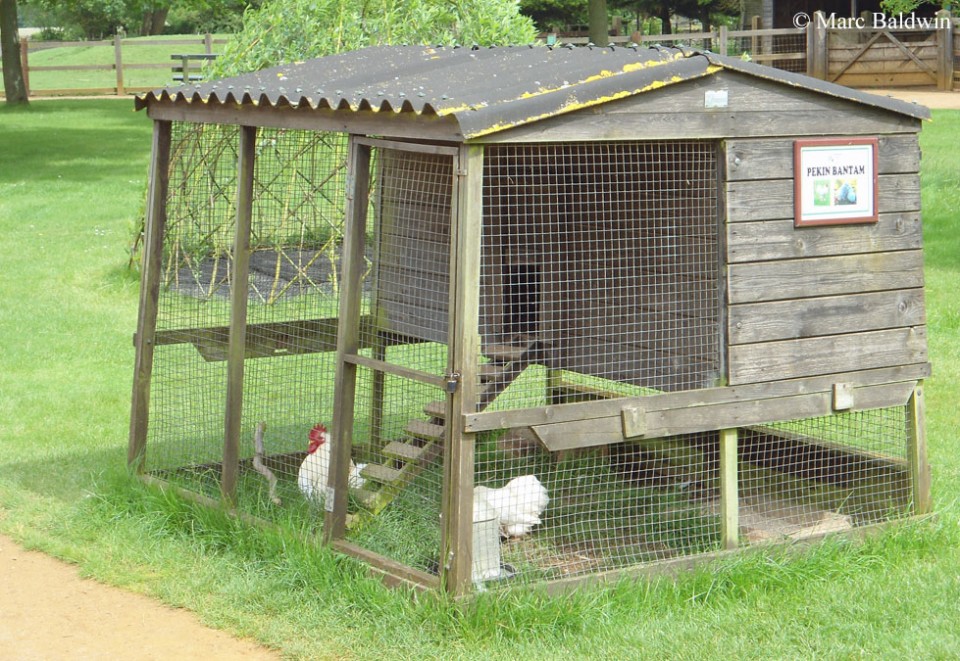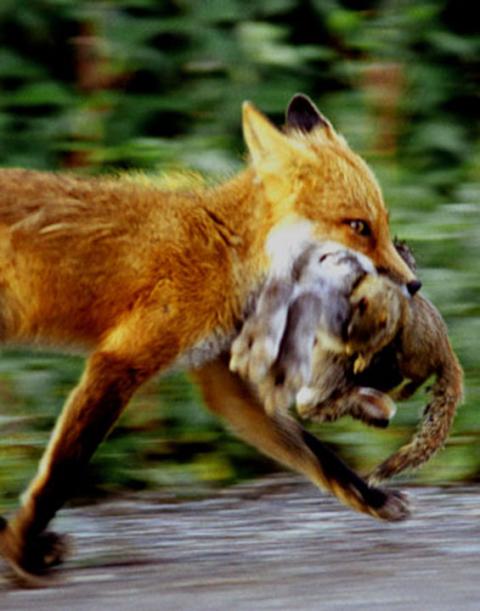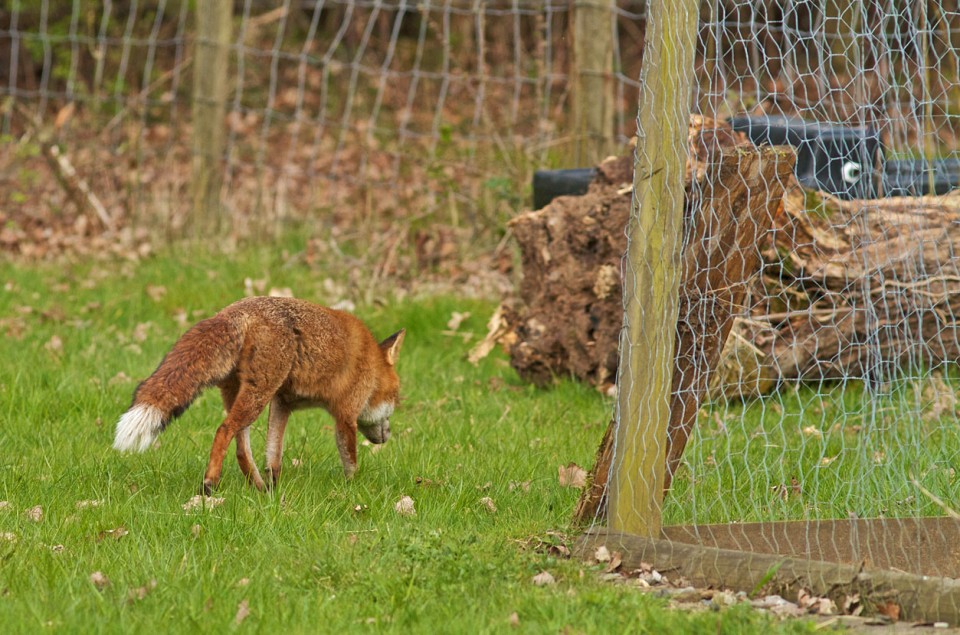Summary
Not in the sense it is normally used. No predator hates hunting; they can’t or they’d starve. Foxes don’t, however, kill “out of spite” or “for the sake of it”. Surplus killing is a behavioural response to a particular set of circumstances – it’s something foxes and many other predators are programmed to do.
The Details

Arguably the most controversial aspect of fox behaviour, and the one most responsible for their bad reputation, is the act of killing more than they eat. Though we live in a world where 1.3 billion tonnes of useable food is thrown away each year and, as a species, can hardly claim to be blameless in this regard, we nonetheless profess to believe that taking more than you need is greedy and wrong, and that taking more than you need and wasting it is even worse. Whether it’s someone who orders a big meal in a restaurant and leaves most of it uneaten, or a person who takes and wastes more than their share at a buffet or from communal dishes, those who offend against this convention get a bad reputation.
To compound this psychology, we tend to unconsciously extend our standards to other species - we don’t just expect other people to live up to our moral standards, we expect animals to as well. With people this isn’t so much of a problem, because we can, if we choose, address the offender and remind them of the community standards. Where animals are concerned, however, things tend to come unstuck. We cannot simply tell a fox that it is common courtesy that if it must chew through the wire of the coop and nick a chicken, only one should be taken. Or that, if it must kill them all, it should jolly well take them all away so we’re not exposed to a scene of carnage and ‘wasted’ chickens the following morning.
Judge and jury
Logically, most of us accept that animal perception and behaviour necessarily exists outside of the construct of human morality, yet many persist in believing that a fox should somehow know that it’s ‘wrong’ to kill and not eat something, and behave accordingly. Foxes must, therefore, ignore what’s ‘right’ and kill wantonly for the ‘fun of it’ or out of spite, and their behaviour is conscious, wilful and deliberately transgressive.

Spelling it out like this, it sounds bizarre, but it’s an emotional reaction that many people seem to cling to, and one that, like other things we’ve been brought up believing without question, is difficult to change in peoples’ psyches. We know that predators do what they’re programmed to do, without concern for the thoughts and feelings of their prey, and yet we arbitrarily and reflexively judge their behaviour as being ‘evil’ in the context a moral code about which the predator knows and can know nothing. For some, this translates to moral justification for persecuting the fox as vermin: if we’ve convinced ourselves that foxes are evil, killing them becomes acceptable, even desirable (heroic human vs. villainous vulpine), and less emotionally conflicting. For me, Michael Chambers sums this up with a couple of sentences in his 1990 book Free Spirit:
“… man spends so much time in his relationships with his fellows, and particularly with the animal kingdom, demanding that they behave in a manner he prescribes, and often killing them if they do not.”
“In the role of defending advocate for wildlife, I would first demand recognition of the basic tenet: it is not a pre-requisite that wild creatures shall benefit man in order to qualify to be left unmolested.”
So, if foxes don’t do all this killing because they’re the devil in a fur coat or because they don’t like the cut of your jib and are taking it out on your chickens, what is happening? (Note: I’m about to commit the major scientific sin of anthropomorphising an animal. I’m sorry. Really. But it is necessary for the purposes of the explanation.)
Explaining the unexplainable?
We may never know for sure, but it seems unlikely that a fox stumbles across a coop and thinks ‘I’m gonna get caught if those chickens keep squawking like that. I’m gonna have to shut ‘em up!’ or ‘The fox handbook says all human pets and/or livestock must be killed as penance for centuries of persecution’. It seems equally unlikely that the fox thinks ‘If I kill all of those birds it’ll save so much time later’. Instead, a more likely scenario is that the fox finds the coop and spots a potential meal. The fox cases the joint looking for a weakness in the security. If it fails to find a way in the story ends and the fox moves on, although it will almost certainly be back tomorrow for another try.
If the fox does manage to get in – and it’s worth reinforcing the point here that chicken wire was designed to keep chickens in, not to keep foxes out – it’s highly probable that panic will break out among the birds, and this has an important effect: it triggers the fox’s predatory drive. The predatory drive is a deeply embedded survival mechanism that triggers the chase, catch, kill behaviour aimed at securing food. It is an instinctive behaviour that all predators have, and it’s why we’re told not to run screaming if we meet a big cat or bear in the woods – it’s a natural thing for a frail hairless monkey to do, but it’s also the exact behaviour that triggers their prey drive.
It’s not so dissimilar from that instinct that sends people running into burning buildings or diving into rivers to save another person, or even the panic buying we often see prior to the arrival of a big storm. A certain set of circumstances triggers an automatic behaviour. Looking back, we can weigh up how brave or foolish an action might have been, and it’s easy for others to judge, but at the time we act on instinct. Now, once the fox has made a kill out in the open, the stimulus has gone. It’s a bit like a pride of lions chasing down a herd of zebra – by the time they’ve caught one, the others have legged it and there’s nothing running around in the vicinity to trigger another chase.

In a chicken coop or small garden the birds are contained and continue to flap in panic, causing the fox’s prey drive to be continuously triggered until the stimulus is gone (i.e. all the birds are dead). Indeed, there have been cases where a fox has broken into a coop and taken only a single bird because the others have remained calm and quiet on nesting shelves above the fox, suggesting it is the movement of live prey in the immediate vicinity that causes this surplus killing*.
Now the fox is confronted with a decision: what to do with all these birds? Nature has strategies to address excesses of supply. In the case of many predators, including our red fox, the solution is to bury the leftovers for use later – a process we call caching. This behaviour is perhaps best known in rodents and most of us will have seen squirrels running around burying acorns and chestnuts in the park, or a dog bury a bone in the garden. The behaviour is also widespread among wild carnivores too. So, our fox begins the process of removing the dead birds and burying them nearby*.
Generally foxes can carry only one chicken at a time, particularly if the entrance by which they gained access to the coop is narrow. (Interestingly, in my experience foxes always carry their food away to eat in seclusion, away from prying eyes, and I once saw some video footage where a fox had managed to squeeze back out through a small gap under a fence, but found it was unable to drag the chicken through and had to abandon its prize.) Even if the fox manages to escape with a single bird, much can happen while it is gone – the fox may be killed, displaced from its territory, or simply delayed from returning, allowing time for the unfortunate owner to find and remove the dead bodies.

It is fair to say that circumstances sometimes conspire against the fox to prevent it from removing all, sometimes any, of the birds. We do have evidence to suggest, however, that under most circumstances the birds will be removed*. I have three first-hand accounts of this from readers and, perhaps most famously, Martin Hughes-Games told of a similar experience on the BBC’s Autumnwatch back in 2010. In all these cases something prevented the owners from cleaning up the mess left by the fox (in the case of Martin, I believe he left the bodies just to see what would happen) and, over the course of several nights, all the bodies were recovered by a fox. Reader Sue Stephenson, for example, e-mailed me with her experience. Part of Sue’s e-mail is reproduced below with her permission:
“With regards to the mass slaughter and leaving of carcasses - I've always thought, in fairness to the fox, that they probably did intend to come back for all the dead chickens. A couple of years ago a fox got into the run and killed 6 point-of-lay hens. It was in July 2007 when we had the floods and with the water pouring into our kitchen I couldn't spare time or the heart to deal with the dead birds but the following day when I returned - all the bodies had gone.”
We cannot know whether it was the same fox that came back for them all, but given that foxes are strongly territorial it seems probable.
So, in a nutshell, so-called surplus killing is a response to a specific, for want of a better word ‘artificial’, situation wherein skittish prey in a confined area are unable to escape and continually trigger a predator’s prey drive. Caching is the evolved behaviour that exploits the resulting carnage.
Hormones at first sight
Finally, we arrive at the question of whether the fox enjoys its killing spree. This is not a question I plan to dwell on because I do not believe it is one that can be answered satisfactorily. I am, however, frequently drawn on this subject and so I will briefly set out my personal opinion.
I suspect that in the majority of hunts, fun, as we tend to define it, doesn’t enter into it – the fox pursues its prey in accordance with its nature, in the same way that humans prepare a meal at home, book a table at a restaurant, or, more elementally, cook their food over a fire in the woods. Food is necessary for survival, for both us and the fox. We may enjoy cooking and there’s an inveterate pleasure in the act of eating, the satisfying of hunger, but in the end we eat because we must. Most of us are fortunate in not being forced into contemplating where our food comes from or how it came to be handily shrink wrapped in the shop. For a predator, killing is a pivotal part of its existence; it's not an exercise-based leisure activity. Quite simply, to the exclusion of scavenging (which is highly unpredictable), if they don't kill something and eat it they will starve to death.

At the same time, it seems reasonable to assume that an animal wouldn't perform an action, especially one as dangerous as hunting another animal, if the experience was highly aversive. Think about reproduction: to ensure they're passed to successive generation, our genes have programmed us to be rewarded (with the 'hormone of love', oxytocin) for having sex. If sex wasn't fun, nobody would engage in it and the species would die out, test tube wielding geneticists notwithstanding. Having fun doing something and doing something because it’s fun are two different things, though. Using our reproductive example, we generally aren’t driven to have sex because it’s fun. We’re driven by, now how can I put this without losing my Google rankings, amorous urges – the fun is a bonus and ensures sex isn’t shied away from when the urge strikes. Similarly, predators are driven by an urge to hunt – whether they get a kick out of it too is immaterial.
To be evil or callous you need a moral/ethical code that you can mindfully violate and against which you can be judged by your peers – as far as I know, only humans have this.
----------------------------------------------------------------------------
* Footnote
There are some interesting examples of surplus killing in the scientific literature where sitting birds have been killed in large numbers and haven’t been cached. Perhaps the best-known example were the black-headed gulls killed by foxes at the Ravenglass reserve in Cumbria during the early 1960s. The situation was meticulously documented by Hans Kruuk in his January 1964 paper to the journal Behaviour. Kruuk found that although the foxes cached many of the eggs they took, they seldom cached gulls that they killed (typically burying fewer than 5%), which meant that nearly 1,500 adult gulls, and many more chicks, were killed and abandoned by the foxes during the three years of the study.
More curious still was that the birds were killed on nights when the weather (very dark or stormy conditions) caused the birds to sit tight on their nests – Kruuk and his coworkers reported that they could walk right up to the birds and pick them up off the nests on such nights without the bird protesting. Consequently, even when one gull was killed there was no panicky prey-like behaviour from its neighbour to distract the fox and re-trigger its prey drive. The reason for this curious behaviour remains unexplained; but it is interesting to note that it only happened during a very specific weather conditions, which seemed to cause the birds to lose their antipredator response and affect the behaviour of the foxes.

There are observations to suggest that how neatly a fox caches food can depend on how hungry it is, with caches made by satiated foxes being more haphazard. If this is representative, perhaps the superabundance of easily-caught birds had in some way impaired the foxes’ caching response. Alternatively, with several hundred birds killed on some nights perhaps there were physically too many to handle, like being confronted by a very messy room and not knowing where to start to clean it. Writing about the research eight years later, one of Kruuk’s coworkers, Niko Tinbergen, considered that the prey drive may be more sensitive than I have intimated and may not even require the flapping panic. In the penultimate chapter of his book The Animal in its World, Tinbergen explains:
“It is furthermore quite possible that a hunting animal such as the fox can hope to be successful (even on favourable nights) only if it possesses an unquenchable urge to kill on sight, to kill immediately whenever opportunity offers. It is quite possible that it cannot afford to curb its instant reaction towards ‘moving-prey-within-reach’ under any circumstances whatsoever.”
For me this plausibly explains the predation of so many gulls, but does not help us explain why a well-established behaviour such as caching failed in this case. All we can say is that, based on the available evidence, the lack of any desire to cache adult birds seems to be aberrant behaviour that occurs very infrequently in the wild. Most foxes do cache surplus food, even from a very early age.